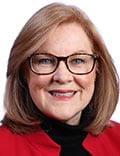PCP-Cardiologist Teamwork: Clinicians Discuss How-Tos
Complaints of chest pain brought the woman into her primary care physician’s (PCP) office. Her doctor, Asha Shajahan, MD, a family practice physician at Corewell Health in Novi, Michigan, examined her thoroughly, determined that the patient had atherosclerosis of the coronary artery, and referred her to a cardiologist she had worked with before.

The cardiologist performed an angioplasty with stent placement, hospitalized the woman for 3 days, and then prescribed blood thinners and other medication changes. Then came the hand off back to Shajahan.
It couldn’t have been smoother, Shajahan tells Medscape Medical News. Despite the complexity and urgency of the case, Shajahan said she grasped the situation immediately, and the continuum of care went on successfully. Teamwork was the key, she said.
The cardiologist reached out right after the procedure, inviting Shajahan to read her extensive notes. The cardiologist also offered her number and invited Shajahan to reach out by phone or text with any questions to handle the ongoing care of the patient, whom they would now share.
The interactions didn’t just make life easier for Shajahan and the cardiologist. When the patient discovered that her two physicians had spoken, she told Shajahan, “I’m happy you and my cardiologist not only know each other but are discussing my care.”
Not every interaction between PCP and cardiologist goes that smoothly, but it should be the goal, Shajahan and others told Medscape Medical News.
Teaming Up to Manage Heart Disease and Diabetes
More than 127 million adults in the United States have some form of cardiovascular disease; more than 29 million adults are diagnosed with diabetes, with another 8 million undiagnosed. And of course, some patients have both heart disease and diabetes, further complicating the clinical picture.
Caring for these millions of patients falls greatly on PCPs and cardiologists.
Coordination between these physicians is essential to produce a care plan to address medication management, dietary guidance, regular monitoring, and other needs. Clinicians from each area told Medscape Medical News what works, what doesn’t, and what physicians from each area wish those from the other area would do better. Here’s, their best advice and tips.
It Starts With Respect
Since PCPs are patients’ first stop, they bear the brunt, or at least the initial brunt, of the millions of patients with heart disease, diabetes, or both. Respect is crucial, said cardiologist Mustafa Husaini, MD, MBA, assistant professor of medicine at WashU Medicine, St. Louis.
“Primary care doctors have one of the hardest jobs in medicine,” he said. “They’re dealing with something different every 15 minutes.”

Of course, that respect is a two-way street, said Husaini, who is also the American College of Cardiology Cardiovascular Management Council Chair. To him, that PCPs should ideally give the cardiologist they are referring patients to as much information as possible.
“Often we get referrals, and patients don’t always know why they are being referred,” he said.
It’s crucial for the patients to know why they are being referred, he said, especially if the appointment will be months away due to waiting times. That often leaves patients feeling stressed about the unknown. So, the lack of information is a disservice to them as well, he said.
While there are no specific guidelines on how primary care and cardiology physicians should work together to manage care, “part of our primary care training is knowing how to interact with a specialist,” Shajahan said. “We are constantly talking to specialists.”
While she and other PCPs are careful to refer when a cardiologist’s expertise is needed, what she wishes cardiologists would realize — once that patient is handed back to primary care — is that patients tend to listen closely to what their primary care doctor says and advises.
Research bears out her statement. In a recent survey of more than 2500 adult patients, more than half said they preferred to see their own PCP (rather than another team clinician) for follow-up of a chronic condition and to see their own PCP for their annual checkup rather than wait for another if appointments were scarce.
Shajahan recommends that cardiologists send PCPs a short note in bullet form, explaining, “This is what I’d like you to follow.” A brief phone call — even 10 minutes — is also always welcome, she said. “It makes it easier to comprehend and understand what’s needed rather than reading through pages and pages of notes and test results.”
Using Technology to Advantage
Electronic health records have been a huge help for coordinating care between PCPs and cardiologists, said Natalie Hamilton, MD, family medicine physician in Denver and senior instructor in the Department of Family Medicine at the University of Colorado Anschutz Medical Campus, Aurora, Colorado.
“Because we are such a large medical campus, a lot of time we are referring within our system,” she said. “I am able to see in a quick snapshot when the patient is going to the cardiologist. I can see the note from the cardiologist after the visit and see what they talked about in their plan.”
And, she said, she has reached out to the cardiologist to ask about anything that needs clarification.

That kind of coordinated back-and-forth is also possible within smaller systems or with those physicians outside the health plan’s system, she said. Hamilton has worked with cardiologists outside of her system, with notes faxed over to her, supplemented by a follow-up phone call to their offices.
If she’s unsure about whether the time is right for a referral, the system has the option for PCPs to do an electronic consult with the cardiologist, explaining the case and asking if a referral is appropriate. As there is a copay of $30 required, Hamilton gets patient consent for that first. “Most patients are OK with that.”
The option for a quick consult with a cardiologist is valuable, agreed Kimberly Petrick, MD, a family medicine physician at Kaiser Permanente, Santa Monica, California, who also has the ability to message and request a quick consult within her large healthcare system.
Developing and Maintaining Collaborations
“Collaborating with your referring doctors and keeping them informed is essential,” said cardiologist Gina Price Lundberg, MD, professor of medicine at Emory University School of Medicine and medical director of the Emory Women’s Heart Center in Atlanta.

As a specialist in women and heart disease, caring for women with heart issues during pregnancy through menopause, she maintains offices within the setting of primary care and internal medicine as well as within obstetrics and gynecology. “In both situations, it is ideal to be physically present among these primary care doctors so they can grab me for curbside consults or see if I have time to see one of their patients immediately,” said Lundberg, who is also chair of the American College of Cardiology Women in Cardiology Leadership Council.
She told Medscape Medical News, “I have been in the community for 31 years and have developed a strong relationship with primary care doctors and other referring doctors.”
As multiple large healthcare systems have evolved, not sharing the same electronic health records, it has become more complicated, she said. But it’s not impossible, even if the best care for your patient is inside a different system, she said.
“I make sure every referring doctor gets a note every time I see the patient and I have a low threshold to call them if there is something they need to know about urgently.”
Is a Smaller Circle Better?
When PCPs concentrate referrals to a smaller group, productive relationships develop, some research has found. Those repeated interactions improve the performance of the team, the study found, and result in lower overall use of healthcare services.
In a Harvard study, researchers found that patients benefit when specialists know and train with the referring physicians. Patients seen by a specialist who co-trained with their PCP rated the specialist care 9 percentage points higher than those not seen by a specialist who co-trained with the referring doctor.
Referral Resistance? Not Common
When referral to cardiology is needed, Hamilton, the Denver PCP, said most patients don’t resist the idea. “I do definitely have some patients who like to keep everything in one place.” That’s where it can be easier to practice within a larger system, such as hers, she said. Since all physicians are under the same “umbrella,” patients may not feel like it’s an “outside” referral.
However, “on average, most are very accepting.”
What often develops for stable patients, she said, is seeing the cardiologist annually and her three or four times a year.
Shajahan, Husaini, Hamilton, Petrick, and Lundberg had no disclosures.


 Admin_Adham
Admin_Adham


